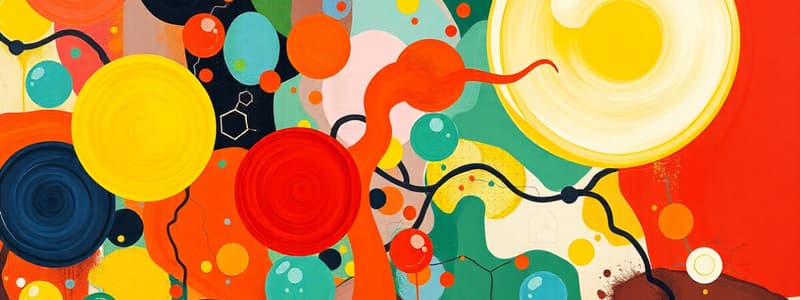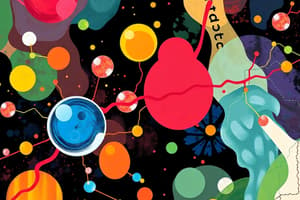Podcast
Questions and Answers
What is true about monosaccharides?
What is true about monosaccharides?
- They can be broken down into simpler sugars.
- They are always composed of six carbon atoms.
- They contain more than one sugar unit.
- They cannot be hydrolyzed into simpler compounds. (correct)
Which of the following is classified as a disaccharide?
Which of the following is classified as a disaccharide?
- Glucose
- Galactose
- Sucrose (correct)
- Starch
What characterizes an aldopentose?
What characterizes an aldopentose?
- It has five carbon atoms and an aldehyde group. (correct)
- It has five carbon atoms and a ketone group.
- It is a simple sugar with no functional groups.
- It contains less than three carbon atoms.
What leads to lactose intolerance?
What leads to lactose intolerance?
How does sucrose contribute to dental caries?
How does sucrose contribute to dental caries?
Which statement correctly describes the composition of starch?
Which statement correctly describes the composition of starch?
What occurs when human teeth are rinsed with a sucrose solution?
What occurs when human teeth are rinsed with a sucrose solution?
Which of the following best describes an oligosaccharide?
Which of the following best describes an oligosaccharide?
Flashcards
Carbohydrates
Carbohydrates
Organic compounds containing carbon, hydrogen, and oxygen, often in a 1:2:1 ratio (e.g., Cn(H2O)n).
Monosaccharides
Monosaccharides
Simple sugars; cannot be hydrolyzed into simpler sugars.
Disaccharides
Disaccharides
Two monosaccharides linked together by a glycosidic bond.
Polysaccharides
Polysaccharides
Signup and view all the flashcards
Glycosidic bond
Glycosidic bond
Signup and view all the flashcards
Starch
Starch
Signup and view all the flashcards
Dental Caries
Dental Caries
Signup and view all the flashcards
Lactose Intolerance
Lactose Intolerance
Signup and view all the flashcards
Study Notes
Carbohydrates Chemistry & Metabolism
- Carbohydrates are compounds derived from glycogen and glucose, such as starch and sucrose.
- They are hydrated carbons (contain hydrogen and oxygen in the same proportion as H₂O).
- The formula of carbohydrates is Cn(H₂O)n, where n = 3 or more.
Classification of Carbohydrates
- Monosaccharides: Single sugar units that cannot be hydrolyzed into simpler compounds.
- Disaccharides: Two sugar units linked together.
- Oligosaccharides: 3-10 sugar units.
- Polysaccharides: Polymers of more than 10 sugar units.
Classification of Monosaccharides
- Classified by the number of carbon atoms (trioses, tetroses, pentoses, hexoses).
- Classified by the active sugar group (aldoses or ketoses).
- Further classified by both the active group and the number of carbon atoms (e.g., aldopentose, Aldohexose, ketohexose).
Disaccharides Examples
- Maltose (Malt sugar): Glucose + Glucose
- Lactose (Milk sugar): Galactose + Glucose
- Sucrose (Cane sugar): Glucose + Fructose
Lactose Intolerance
- Cause: Deficiency of lactase. This can be congenital (due to gene defect) or acquired (after surgery, infection). Aging can also lead to a reduction in lactase production.
- Symptoms: Fermentation by intestinal bacteria causes gas production, distension, nausea, colic, and diarrhea.
- Management: Intake of lactose-free milk and yogurt (lactose in yogurt is partially hydrolyzed during fermentation).
Sucrose and Dental Caries
- Rinsing human teeth with sucrose solution for 3 minutes will lower plaque pH from 6.5 to 5.0, which remains low for 40 minutes.
- The acid produced damages the enamel (causing demineralization).
Simple Polysaccharides
- Starch: Plant storage carbohydrate. It has two types of chains:
- Amylose: Straight chains of α-D glucose linked by α 1-4 glycosidic bonds.
- Amylopectin: Branched chains of α-D glucose linked by α 1-4 and α 1-6 glycosidic bonds.
- Glycogen: Animal storage carbohydrate, highly branched chains of α-D glucose linked by α 1-4 and α 1-6 glycosidic bonds.
Cellular Types of Carbohydrates (Summary Table)
| Carbohydrate | Source | Subunit | Bonds | Branches |
|---|---|---|---|---|
| Cellulose | Plant | β-glucose | 1-4 | No |
| Starch (Amylose) | Plant | α-glucose | 1-4 | No |
| Starch (Amylopectin) | Plant | α-glucose | 1-4, 1-6 | Yes |
| Glycogen | Animal | α-glucose | 1-4, 1-6 | Yes |
Studying That Suits You
Use AI to generate personalized quizzes and flashcards to suit your learning preferences.



